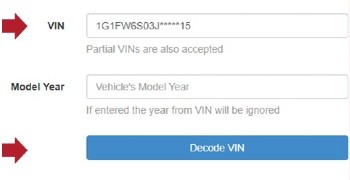For automotive repair professionals, accessing detailed and accurate vehicle information is crucial. The Vehicle Identification Number (VIN) serves as the key to unlocking a wealth of data essential for diagnostics, repair, and maintenance. Understanding how to effectively utilize the Information Vin Number is a fundamental skill for any expert in the automotive service industry.
Every vehicle manufactured is assigned a unique 17-character VIN, a standardized code that contains a structured set of information about the vehicle. This number is not just a random identifier; it’s a carefully constructed sequence that reveals critical details about the car’s origin, specifications, and manufacturing details. Decoding the information VIN number allows you to determine the manufacturer, country of origin, year of manufacture, vehicle attributes (body style, engine type, transmission), and the specific plant where the vehicle was assembled.
Why is this information VIN number so vital for car repair? Firstly, it ensures accuracy in parts identification. When ordering replacement parts, especially for complex systems, the VIN guarantees you are selecting components specifically designed for the vehicle you are servicing. Secondly, the VIN can provide access to manufacturer-specific diagnostic information and repair procedures. Many databases and online resources use the VIN to filter and deliver the precise technical data relevant to the exact vehicle model and configuration. Furthermore, the VIN is indispensable for checking vehicle recall information, ensuring safety and compliance during repairs. It can also be used to access vehicle history reports, which may reveal previous damage or maintenance records, providing valuable context for current repairs.
One readily available tool to access basic information VIN number is the National Highway Traffic Safety Administration (NHTSA) VIN decoder. This free online resource allows you to quickly identify the manufacturing plant of a vehicle. Here’s how to use it:
Step 1: Navigate to the NHTSA VIN Decoder website and input the complete VIN.
Example of the NHTSA VIN decoder input field where you enter the vehicle identification number to initiate the decoding process.
To begin, visit the NHTSA VIN decoder at https://vpic.nhtsa.dot.gov/decoder/. Enter the full 17-character VIN into the provided text box. After entering the VIN, click the “Decode VIN” button to proceed.
Step 2: Locate the manufacturing plant details in the decoder results.
Screenshot displaying the NHTSA VIN decoder output, highlighting the field that provides the vehicle’s manufacturing plant location and country of origin.
After decoding, review the results page. At the bottom of the page, you will find a field that clearly indicates the “Build Plant” and “Country” where the vehicle was manufactured. This information, while seemingly basic, can be useful in verifying vehicle origin and specifications.
While the NHTSA decoder offers a starting point for accessing information VIN number, for comprehensive automotive repair, consider utilizing professional-grade VIN decoding tools and databases. These advanced resources provide a much deeper dive into the VIN data, offering detailed vehicle specifications, parts catalogs, wiring diagrams, and diagnostic codes, all linked directly to the information VIN number. Investing in such tools significantly streamlines the repair process, reduces errors, and enhances the quality of service you can provide.
In conclusion, the information VIN number is an indispensable asset in modern automotive repair. Mastering the ability to decode and utilize VIN information is essential for efficient diagnostics, accurate parts ordering, and providing top-tier service to your clients. Whether using free tools like the NHTSA decoder or investing in professional databases, leveraging the power of the VIN is key to success in today’s automotive repair landscape.
